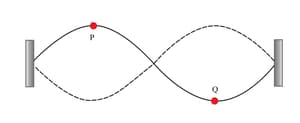Consider a string with both ends fixed. A standing wave in the second harmonic mode is established on the string, as shown in the diagram. The speed of wave is .

Consider the vibrations of two points on the string, P and Q. The displacement of point P is given by the equation where in and is in seconds. Calculate the length of the string.


Important Questions on Waves
Consider a string with both ends fixed. A standing wave in the second harmonic mode is established on the string, as shown in the diagram. 
Consider the vibrations of two points on the string, P and Q. The displacement of point P is given by the equation where in and is in seconds. State the phase difference between the oscillation of point P and that of point Q. Hence write down the equation giving the displacement of point Q.
A horizontal aluminium rod of length is hit sharply with a hammer. The hammer rebounds from the rod later. Explain why the hammer rebounds.
A horizontal aluminium rod of length is hit sharply with a hammer. The hammer rebounds from the rod later. Calculate the speed of sound in aluminium.
A horizontal aluminium rod of length is hit sharply with a hammer. The hammer rebounds from the rod later. Calculate the speed of sound in aluminium. The hammer created a longitudinal standing wave in the rod. Estimate the frequency of the sound wave by assuming that the rod vibrates in the first harmonic.
The diagram shows a print P on a string at a particular instant of time. A transverse wave is travelling along the string from left to right.
Which is correct about the direction and the magnitude of the velocity of point P at this instant?
The graph shows the displacement of a medium when a longitudinal wave travels through the medium from left to right. Positive displacements correspond to motion to the right. Which point corresponds to the centre of the compression?


